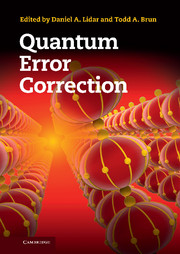Book contents
- Frontmatter
- Contents
- List of contributors
- Prologue
- Preface and guide to the reader
- Acknowledgements
- Part I Background
- 1 Introduction to decoherence and noise in open quantum systems
- 2 Introduction to quantum error correction
- 3 Introduction to decoherence-free subspaces and noiseless subsystems
- 4 Introduction to quantum dynamical decoupling
- 5 Introduction to quantum fault tolerance
- Part II Generalized approaches to quantum error correction
- Part III Advanced quantum codes
- Part IV Advanced dynamical decoupling
- Part V Alternative quantum computation approaches
- Part VI Topological methods
- Part VII Applications and implementations
- Part VIII Critical evaluation of fault tolerance
- References
- Index
5 - Introduction to quantum fault tolerance
from Part I - Background
Published online by Cambridge University Press: 05 September 2013
- Frontmatter
- Contents
- List of contributors
- Prologue
- Preface and guide to the reader
- Acknowledgements
- Part I Background
- 1 Introduction to decoherence and noise in open quantum systems
- 2 Introduction to quantum error correction
- 3 Introduction to decoherence-free subspaces and noiseless subsystems
- 4 Introduction to quantum dynamical decoupling
- 5 Introduction to quantum fault tolerance
- Part II Generalized approaches to quantum error correction
- Part III Advanced quantum codes
- Part IV Advanced dynamical decoupling
- Part V Alternative quantum computation approaches
- Part VI Topological methods
- Part VII Applications and implementations
- Part VIII Critical evaluation of fault tolerance
- References
- Index
Summary
One of the applications of quantum error correction is protecting quantum computers from noise. Certainly, there is nothing particularly quantum mechanical in the idea of protecting information by encoding it. Even ordinary digital computers use various fault tolerance methods at the software level to correct errors during the storage or the transmission of information; e.g., the integrity of the bits stored in hard disks is verified by using parity checks (checksums). In addition, for critical computing systems such as those inside airplanes or nuclear reactors, software fault tolerance methods are also applied during the processing of information; e.g., airplane control computers compare the results from multiple parallel processors to detect faults. In general, however, the hardware of modern computers is remarkably robust to noise, so that for most applications the processing of information can be executed with high reliability without using software error correction.
In contrast to the ease and robustness with which classical information can be processed, the processing of quantum information appears at present to be much more challenging. Although constructing reliable quantum computing hardware is certainly a daunting task, we have nevertheless strong hopes that large-scale quantum computers, able to implement useful long computations, can in fact be realized. This optimism is founded on methods of quantum fault tolerance, which show that scalable quantum computation is, in principle, possible against a variety of noise processes.
- Type
- Chapter
- Information
- Quantum Error Correction , pp. 126 - 160Publisher: Cambridge University PressPrint publication year: 2013



